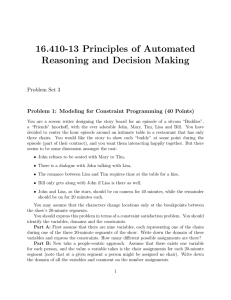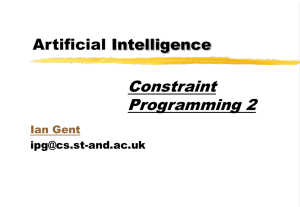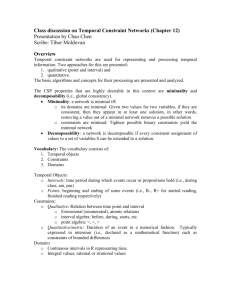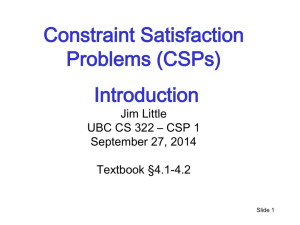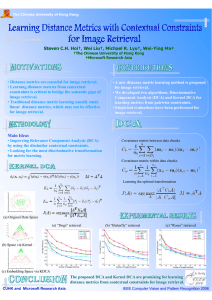Functional Elimination and 0/1/All Constraints
advertisement
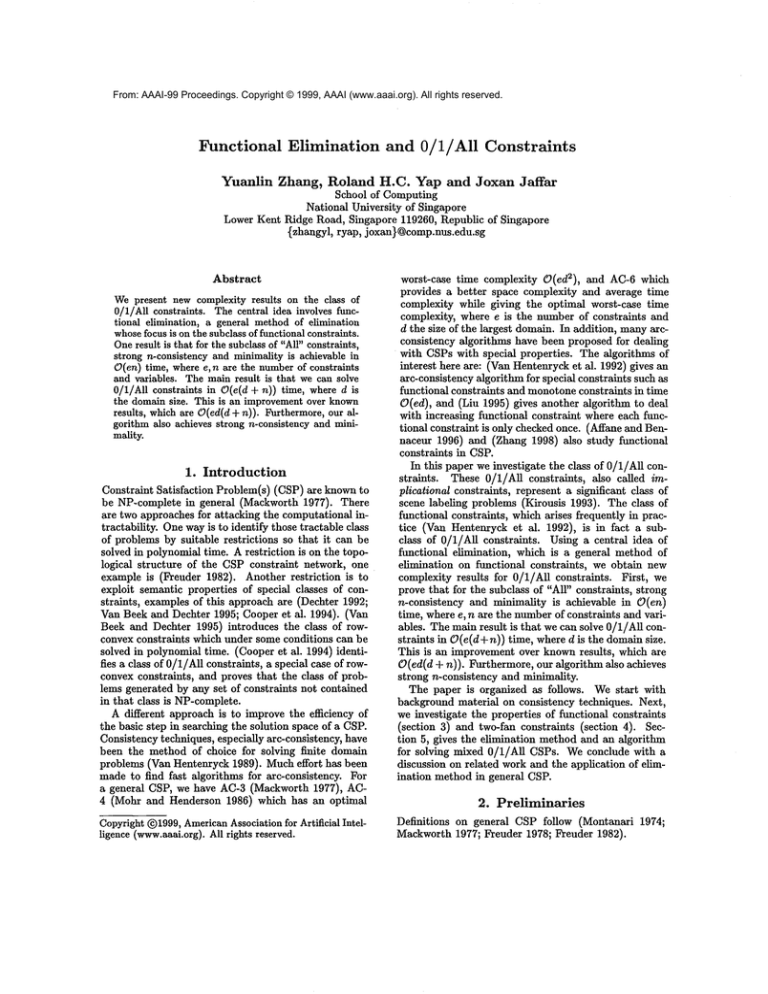
From: AAAI-99 Proceedings. Copyright © 1999, AAAI (www.aaai.org). All rights reserved.
Functional
Elimination
and 0/1/All
Constraints
Yuanlin Zhang, Roland H.C. Yap and Joxan Jaffar
School of Computing
National University of Singapore
Lower Kent Ridge Road, Singapore 119260, Republic of Singapore
{zhangyl, ryap, joxan}@comp.nns.edu.sg
Abstract
Wepresent new complexity results on the class of
0/1/All constraints. The central idea involves functional elimination, a general methodof elimination
whosefocus is on the subclass of functional constraints.
Oneresult is that for the subclass of "All" constraints,
strong n-consistency and minimality is achievable in
O(en) time, where e, n are the numberof constraints
and variables. The main result is that we can solve
0/1/All constraints in O(e(d + n)) time, where d is
the domainsize. This is an improvementover known
results, which are O(ed(d-t-n)). Furthermore, our algorithm also achieves strong n-consistency and minimality.
1. Introduction
Constraint Satisfaction Problem(s) (CSP) are known
be NP-complete in general (Mackworth 1977). There
are two approaches for attacking the computational intractability. Onewayis to identify those tractable class
of problems by suitable restrictions so that it can be
solved in polynomial time. A restriction is on the topological structure of the CSPconstraint network, one
example is (Freuder 1982). Another restriction
is
exploit semantic properties of special classes of constraints, examples of this approach are (Dechter 1992;
Van Beck and Dechter 1995; Cooper et al. 1994). (Van
Beck and Dechter 1995) introduces the class of rowconvex constraints which under some conditions can be
solved in polynomial time. (Cooper et al. 1994) identifies a class of 0/1/All constraints, a special case of rowconvex constraints, and proves that the class of problems generated by any set of constraints not contained
in that class is NP-complete.
A different approach is to improve the efficiency of
the basic step in searching the solution space of a CSP.
Consistency techniques, especially arc-consistency, have
been the method of choice for solving finite domain
problems (Van Hentenryck 1989). Mucheffort has been
made to find fast algorithms for arc-consistency. For
a general CSP, we have AC-3 (Mackworth 1977), AC4 (Mohr and Henderson 1986) which has an optimal
Copyright(~)1999, AmericanAssociation for Artificial Intelligence (www.aaai.org).All rights reserved.
worst-case time complexity O(ed2), and AC-6 which
provides a better space complexity and average time
complexity while giving the optimal worst-case time
complexity, where e is the number of constraints and
d the size of the largest domain. In addition, manyarcconsistency algorithm~ have been proposed for dealing
with CSPs with special properties. The algorithm.q of
interest here are: (Van Henteurycket al. 1992) gives
arc-consistency algorithm for special constraints such as
functional constraints and monotoneconstraints in time
O(ed), and (Liu 1995) gives another algorithm to deal
with increasing functional constraint where each functional constraint is only checked once. (Affane and Bennaceur 1996) and (Zhang 1998) also study functional
constraints in CSP.
In this paper we investigate the class of 0/1/All constraints.
These 0/1/All constraints, also called implicational constraints, represent a significant class of
scene labeling problems (Kironsis 1993). The class
functional constraints, which arises frequently in practice (Van Henteuryck et al. 1992), is in fact a subclass of 0/1/All constraints. Using a central idea of
functional elimination, which is a general method of
elJmlnation on hmctional constraints,
we obtain new
complexity results for 0/1/All constraints. First, we
prove that for the subclass of "All" constraints, strong
n-consistency and minimality is achievable in O(en)
time, where e, n are the numberof constraints and variables. The main result is that we can solve 0/1/All constraints in O(e(d+n)) time, where d is the domain size.
This is an improvement over known results, which are
O(ed(d + n)). Furthermore, our algorithm also achieves
strong n-consistency and Inlnlmality.
The paper is organized as follows. We start with
background material on consistency techniques. Next,
we investigate the properties of functional constraints
(section 3) and two-fan constraints (section 4).
tion 5, gives the e|imlnation method and an algorithm
for solving mixed 0/1/All CSPs. We conclude with a
discussion on related work and the application of elimination method in general CSP.
2. Preliminaries
Definitions on general CSP follow (Montanari 1974;
Mackworth 1977; Freuder 1978; Freuder 1982).
Definition 1 A Constraint Satisfaction
Problem (N,
D, C) consists of a finite set of variables N
{1,... ,n}, a set of domains D = {D1,... ,Dn}, where
i E Di, and a set of constraints C = {eij [ i,j e N},
where each constraint cij is a binary relation between
variables i and j. For the problem of interest here, we
require that (x, y) e cij if and only if (y, x) Ccji. There
is always a graph G = (V, E) associated with the CSP
where V = N and E : {(i,j)
[ 3cij ¯ C}. solution
to a constraint satisfaction problem is an instantiation
of the variables which satisfies all the constraints in the
problem.
Throughout this paper, we will use n to represent the
numberof variables, d the size of the largest domain, C
the set of constraints of the CSP, and e the number of
constraints in C.
Definition 2 A CSPis k-consistent if and only if given
any instantiation of any k - 1 variables satisfying all of
the constraints amongthose variables, there exists an
instantiation of any kth variable such that the k values
taken together satisfy all of the relations amongthe k
variables. A CSPis strongly k consistent if and only
if it is i-consistent for all i < k. A CSPis minimal if
each pair of values allowed by each of the constraints is
a part of a solution of the CSP.
Well known consistency
techniques like arc and
path consistency correspond to strong two and threeconsistency.
Wenow recall definitions of constraints with some
special properties.
Definition 3 (Cooper et al. 1994) A constraint, clj,
a directed 0/i/All constraint if for each value x E Di,
cij satisfies the following:
1. for any value y ¯ Dj, (x, y) ¢ cij,
2. for any value y ¯ Dj, ( x, y) ¯ cij, or
3. there is a unique value y ¯ Dj, ix, y) ¯ clj.
A constraint is called functional if either condition 1
or condition 3 is satisfied. A two-fan constraint, also
called an "All" constraint, cij is a constraint where
there exists x E Di and y ¯ Dj such that cij =
(x × Dj)U(y Di). A fa n-out constraint is a c onstraint
cij such that 3x ¯ Di and Vy (x, y) ¯ cij.
Property 1 (Cooper et al. 1994) After enforcing arcconsistency on O//1//All constraints, any O/Ill/All constraint is either a trivial relation, a bijective function
or a two-fan constraint. A trivial relation cij is either
empty or Di × D
1.
Anexample of two-fan (left) and fan-out (right)
straints are illustrated as follows:
Property 2 (Cooper et al. 1994) The set of O//1/All
constraints is closed under the operations involved in
path consistency:
1. Intersection of constraints.
2. Composition, o, where cij o cjk = {(p, q) ] 3r
Dj, such that (p, r) cij A (r , q) E cjk
Definition 4 (Van Beek and Dechter 1995) A binary
relation cij represented as a ( 0, 1)-matrix is row convex
if and only if in each row all of the ones are consecutive;
that is, no two ones within a single row are separated
by a zero in that same row.
Both functionM and 0/1/All constraints are row convex. For row convex constraints there is the result:
Theorem 1 (Van Beek and Dechter 1995) For a pathconsistent CSP, if there exists an ordering of the domains DI , . . . , Dnsuch that all constraints are row convex, the CSPis minimal and strongly n-consistent.
It is obvious that a path consistency enforcing Mgorithm will make the 0/1/All constraint system minimal
by theorem 1 and property 1 and 2, and thus the problem is solved. However,the complexity of a typical path
algorithm is high, such as O(nad3) in (Mohr and Henderson 1986) and O(n3dz) in (Devile et al. 1997).
this paper, we obtain more efficient algorithms.
3. The O (one)
algorithm
Wefirst present an algorithm for a CSP( N, D, C) which
contains only functional constraints (functional CSPfor
short) and then give the analysis of certain properties
of these constraints.
For the sake of simplicity and clarity, we assume the
graph of the CSPis connected without loss of generality.
The algorithms are shownin figure 1 and figure 2.
Algorithm O((N,D, C))
ViVx, x E Di x.touched +-- false;
Select any variable i E N
for each value z of i {
z.touched ~-- true;
~.delete +-- false;
if not Propagate(z, i) then z.delete ~-- true;
)
ViVx, z ¯ Di
if (not x.touched) or (x.coordinate).delete
then
remove x from i;
)
Figure 1: O-algorithm for ftmctional CSP
The O-algorithm uses an adaptation of brute force
searching (Garey and Johnson 1979; Cooper et al. 1994)
which takes advantage of the properties of functional
constraints. In contrast, other knownalgorithms (Van
Hentenryck et al. 1992) etc. are based on arc consistency where the emphasis is on finding those values
which can be immediately removed by checking only
a single constraint. The direct brute force searching
Function Propagate (in x, i)
L
for each j E N xj +- null;
xi/--- x;
repeat
Delete first element (y, j) from
for each cjk
if 3z such that (y, z) e cjk then
if xk -~ null then {
z.coordinate ~-- x;
z.touched +- true;
xk +-- z;
n +-- L U ((z, k)};
} end else if xk ¢ z then return false;
until (L ---- 0);
return true;
Figure 2: Propagate algorithm for functional CSP
method here gives a simpler algorithm. The intuition
behind the O-algorithm is that ff at some point in the
search we cannot continue because of inconsistency, we
simply restart at the initial starting point since the path
propagated between the starting point and the current
failure point is unique in a functional CSP.
Definition 5 Given a CSP (N, D, C), its value graph
is G = (V, E) where V = ((Di, x): x e Di, i e N} and
E ---- {((Di,x), (Dj,y)) 3i ,j su ch th at (x,y) ¯ ci j}.
An instantiation tree of G wrt. (Di, x) is a maximal
sub-graph G satisfying:
1. (n,,x)¯
2. G is a tree_, and
3. (Dj, y) ¯ G and (Dj, z) ¯ G implies y = z.
The candidate set wrt. (Di, x) is the set of vertices
G. A value graph G is stable wrt. (Di, x) if all the
instantiation trees wrt. ( Di, x) have the same candidate
set. A candidate set wrt. (Di, x) is unique if the graph
G is stable wrt. each of the vertices in the candidate set.
Finally, a candidate set is complete if it has n vertices.
Property 3 In a functional CSP, x ¯ Di is a part of
a solution if and only if the candidate set wrt. (D~, x)
is unique and complete.
Proof, Obviously, if a candidate set is not complete,
then x cannot be extended to a solution of the functional CSP. The proof of uniqueness is by contradiction. Assumethat for some vertex (Dk, u) in the candidate set of (Di, x), there are two instautiation trees
GI and G" which cover different sets of vertices. Then,
3(Dj,y) ¯ ~ a nd ( Dj,z) ¯ G"where y ~ z. Hence
whenvariable k takes x, variable j takes both y and z,
which is a contradiction. []
It is easy to see that if a candidate set of x ¯ Di is not
complete, or if it is not unique, then all values in the
possible candidate sets wrt. (Di, x) will be invalid. The
value x here is called the coordinate of all other nodes
in the candidate set and i (the variable) is called the
origin. In the O-algorithm, we associate the following
attributes to any value y ¯ Dj:
¯ y.touched indicates ff this value has been tried;
¯ y.delete indicates ff the value should be removed;
¯ y.coordinate is the coordinate of y with regard to an
origin i.
Theorem2 Given a functional CSP , the O-algorithm
is correct and enforces the CSP to be minimal and
strongly n-consistent. The complexity of O-algorithm
is O(ed).
Proof.
(1) The purpose of Propagate is to identify whether
candidate set wrt. x ¯ Di is complete and also unique.
The repeat loop is to find an instantiation tree wrt.
(Di, x). The condition statement is to check the uniqueness of the candidate set. The Propagate function can
detect only one instantiation tree wrt. (Di,x). Suppose the candidate set is not complete or not unique,
the question is how to delete all the nodes of the other
candidate sets? We use the property that either all
vertices of other candidate sets will never be visited
again; or if it is visited, its coordinate will be labeled as
deleted. This property is implemented by the attribute
x.touched.
(2) The minimal and strong n-consistency is immediate by the above proof.
(3) It is straightforward to showthat the complexity
of O-algorithm is O(ed).
4.
The
A ("All")
algorithm
In this section, we analyse two-fan constraints (also
called "All" constraints) and give an algorithm for this
class. Without loss of generality, we will assume that
the CSP only contains "All" constraints.
For the ease of presentation, we introduce the following notations:
Definition 6 Given a two-fan constraint cij, a pivot
¯
ij
of cij with respect to i, is denoted by the notatzon Pi ¯
The pivot p~J is defined to be the value x ¯ Di such that
Vy ¯ Dj (x, y) ¯ cij. The coordinate ofpj with respect
to Di is defined to be p~J.
A two-fan constraint clj can be simply represented
by the two pivots (p~J, p~J). The use of coordinate here
is analogous to its use in functional constraints. In the
A-algorithm (fig 3) the coordinate is the only value
Di such that j can take any value; and furthermore for
values other than the coordinate there is a unique choice
in j. Thus, the role of coordinates in the A-algorithm
is an adaptation of that in the O-algorithm.
Like the O-algorithm, the A-algorithm is also based
on a search procedure. Before we present the algorithm,
we will first highlight someimportant properties of twofan constraints.
We begin by recalling an important
observation mentioned in (Cooper et al. 1994). Here
we formalize it to emphasize its importance.
Definition 7 Given a CSP (AT, D, C), an instantiation
of a set of variables S c N is separable, if it satisfies
all constraints among S, and any constraint cij E C
between variables i E S and j E N - ,.g allows j to take
any value under the current instantiation of i.
For a single two-fan constraint cij, it is immediate
that the instantiation of i by the pivot p~J is separable.
Proposition 1 Given any GSP (N, D, C) and a separable instantiation of a set of variables. If the CSP
has a solution, then the instantiation is part of some
solution.
The correctness of the above proposition is immediate. The usefulness of this proposition, is that after a
separable instantiation is found, we can subtract out
those variables and all constraints involved in at least
one of those variables, and thus we get a smaller problem to work on (search). By continuing in this fashion,
at the end, the combination of all the separable instantiations is a solution to the original problem. One task
of the A-algorithm is to identify some set of variables
whoseinstantiation is separable since the two-fan constraint gives a strong hint on howto achieve that goal.
The rationale for identifying the separable instantiations, by using some special properties of two-fan fimctions, is that a faster algorithm can be achieved. The
identification
step is achieved using the A-propagate
procedure in a similar fashion to Propagate in theOalgorithm. It works as follows. First, select a starting
variable and iustantiate it to a value x. The next step
is to try to instantiate its ,mlnstantiated neighbor variables. For any ,mlnstantiated k such that there exists
clk E C, we have two choices. In one case, we have
that a¢ is p~k, and this stops the identification procedure
along direction of cik. In the other case, by definition,
we have a unique choice in Dk and thus we need repeat
the propagation above to deal with the neighbors of k
because in the direction of cik the iustantiation has not
yet been found to be separable. Finally we get a set
of variables whoseiustantiation is separable. A trivial
case is that the set of variables is N itself. One problem in the procedure is that the instantiation step for
a variable mayfail. Fortunately, this failure case only
occurs whenthe instantiation step tries to set a variable to two different values which is a contradiction. In
(Cooper et al. 1994), they simply return to the starting
variable and select the next value available. However,
there is a better and faster wayfor resolving the failure
because of the following properties.
The values of D/fall into two classes. One, called the
pivot class P, contains all the pivots while the other,
called the nonpivot class NP, contains all the other
values.
Definition 8 Given a two-fan CSP, a value x E i is
valid if x is part of a solution of the CSP.
Property 4 Given a two-fan CSP and a variable i
with domain Di, we have for the
* NP class of Di: if two of the values are valid, then
any value will also be valid;
. P class of Di: if three of the values are valid, then
any value will also be valid.
Proposition 2 In the procedure of identifying the set
of variables with separable instantiations, if there is a
contradiction, then for the starting variable there are at
most two valid values from the P class and no value
from the NP class.
Proof. It is obvious for NP class. For P class, only
coordinates of the two contradicted values are possible.
For all other values, contradiction still remains. [:1
The A algorithm is given in figures 3 and 4.
AlgorithmA (in (N, D, C))
Selectanyvaluex E Di foranyvariable
iEN
A-Propagate(x, i, N, M, consistent, Pl, P2 );
if not consistent then {
A-Propagate(x,pl, N, M, consistent, -, -);
if not consistent then
A-Propagate(x, pg., N, M, consistent, -, -);
}
if consistent then {
N+--N-M;
ifN ¢ 0 then A((N,D,C));
} else report no solution for (N, D, C)
}
Figure 3: Algorithm for Two-fan Constraints
Theorem 3 Given a two-fan CSP, there exists an algorithm such that strong n-consistency can be enforced
in time complexity O(en).
Proof. The A-algorithm is correct according to
proposition 1 and 2. The complexity of A-Propagate
is at most e and it is called at most n times. The Aalgorithm finds one solution to the CSP. To achieve the
strong n-consistency and mlnimality, it can be slightly
modified using property 4 to check each variable rather
than a set of variables in the main loop. The time complexity is still O(en),the same as in the A-algorithm.
[]
5. The OA algorithm
Now we are in a position to deal with a CSP with
0/1/All constraints. First we simplify the CSP by removing those values not allowed by any complete or
two-fan constraint. Secondly, we remove those complete
constraints and trivial two-fan functions. The above
procedure will take no more than O(ed) time. Now,
the new CSP, called a mixed 1/All CSP, contains only
functional and two-fan constraints.
While it may be
possible to directly use O- and A-algorithms to design
Proc A-Propagate(in x, i, N, out 3/i, con, p1, p2)
L+-O;
for each j E N xj +- null;
con +- true;
for each j such that eij E C {
ij
¯
ij
p.$ "coordinate.. = p. z ;
L ~ Lv{(PT,J)};
}
repeat {
Delete first
for each cjk
if there is
(y,
if xk =
element (y,j)
from L
only one z such that
z) e cjk then
null then {
L~ LU{(z, k)};
Xk t-- z;
z.coordinate +- y.coordinate;
} else if xk ~ z then {
con +-- false;
Pl = y.coordinate;
P2 = z.coordinate;
M+-- all the other unln~tantiated
variables
}
Proe Eliminate (inout (N, D, C), out consistent)
consistent +-- true;
Let i e FV, L +- {j [ 3eij C FC}
repeat {
Select and delete j E L
for each cjk C C {
c~k+- ci~ o c~k;
if 3elk E C e~kthen +- c~k N cik;
switch (c~k)
case 0 : consistency +- false;
return;
case functional: L +- L U {k};
eik (--- c~k;
case fan-out:
ff the pivot appears in Di, remove the
other values, and vice versa;
Ce- C- {e~k};
case two-fan: elk +-- c~k;
}
} until L = O;
Figure 5: Elimination algorithm for functional
straints
Con-
} until (L ---- 0) or (not con);
Algorithm OA-algorithm
an algorithm for the mixed system, we however use an
integrated approach using following theorem.
Theorem 4 Given a CSP, two variables i and j with
cij being functional, we can eliminate one of variable i
or j, to give a new CSPwhich leaves the solution of the
original CSP unchanged.
The motivation of this theorem comes from the Oalgorithm. If there is a functional constraint between i
and j, we can eliminate variable j and redirect all constraints involving j to i. Weremark that other elimination methods in symbolic computation, eg. Gaussian
elimination, can also be thought of as a specialization
of the this elimination idea.
The Eliminate algorithm given in figure 5 uses the
result of theorem 4 but specialized to the context of
0/1/All constraints.
In figure 5, FC = {cij I cij E
C is functional) and FV = {i, j [ 3cij e FC}. The algorithm for solving the mixed CSPis shownin figure 6.
Theorem 5 Given a mixed CSP, the OA-algorithm
has a time complexity of O(ed + en) and enforces the
CSPto be minimal and strongly n-consistent.
Proof. Without loss of generality, in this proof we assume all the functional constraints are connected. After
the elimination procedure, there are only two-fan functions. So, the algorithm is correct and the resulted CSP
{
E|imlnate
( ( N,D,C),consistent);
Figure 4: A-Propagate for two-fan CSP
if consistent then A( ( N, D, C)
else report inconsistency
}
Figure 6: Algorithm for mixed CSP
is minimal and strongly n-consistent. For the elimination procedure, each for loop takes at most d* di times
where di is the degree of node i because all operations
on constraint manipulation can be done in d time. Altogether, we have at most n nodes to deal with and thus
the complexity is O(ed).
6.
Related
Work and
Discussion
The directly related works on 0/1/All constraints are
(Cooper et al. 1994) and (Kirousis 1993), both of which
give a sequential algorithm with time complexity of
O(ed(n + d)) to find one solution. Note that the n-ary
0/1/An
constraints system defined in (Kirousis 1993)
actually a binary constraint system.
In this paper, we obtain better results with a time
complexity of O(en) for a CSP with only "All" constraints and O(e(d + n)) for CSPs with mixed 0/1/All
constraints.
In both cases, this time complexity obtains a solution to the CSPas well as enforcing strong
n-consistency and mlnimality. Thus, a higher degree
of consistency is obtained compared to (Cooper et
al. 1994; Kirousis 1993) with more efficient algorithm.q.
The other related works (Van Henteuryck et al. 1992;
Liu 1995; Affane and Bennaceur 1996; Zhang 1998) are
done mainly in the context of arc consistency. Those
works consider only functional constraints.
Here we
give simpler algorithm.q and an explicit analysis which
fully reflects the global property of functional constraints. Morespecifically, (Van Henteurycket al. 1992)
do not consider finding the global solution, (Liu 1995)
only deals with giving a more efficient algorithm for
dealing with increasing flmctional constraints. (Affane
and Bennaceur 1996) introduces a new kind of consistency, label-arc consistency, and show that the pure
functional constraints with limited extensions to other
constraints can be solved, but no detailed analysis of
their algorithms is given. (Zhang 1998) embeds the
techniques dealing with functional constraint in arcconsistency algorithm.q in a similar way to (Lin 1995)
and proposes the problem of conflict of orienting from
which all the above mentioned algorithm.q (except (Van
Henteurycket al. 1992)) suffer.
Oneresult, which we obtain for the class of hmctional
or "1" constraints, is a new algorithm for functional
constraints with time complexity O(ed). In terms of
time complexity, it is the sameas existing results. However, an advantage of the algorithm here is its conceptual simplicity and ability to achieve minlmality. The
development of the O-algorithm clarifies howfttnctional
elimination can be applied in general, resulting in its use
in the OA-algorithm and the special form of propagation in the A-algorithm. In addition, both the O and
OAalgorithms avoid the problemof conflict of orienting
for CSPs which are known in advance.
An important consequence of the techniques developed here for functional elimination is that functional
elimination is of broad applicability in the more general context of arbitrary CSP problems. It is possible to show that the elimination method for functional
constraints here, for general CSPproblems, will be at
most O(ed2) time. This means that, it can be incorporated into general arc-consistency algorit.hm~ without any increase in time complexity, while at the same
time obtaining more consistency. Other results with
elimination methods on linear equations, (Harvey and
Stuckey 1998; Zhang 1998), also suggest the efficacy of
such elimination approaches.
7.
Conclusion
The 0/i/All constraints play an important role both
theoretically (Cooper et al. 1994) and in practice (Van
Hentenryck 1989; Kirousis 1993). This paper gives fast
algorithms and analyses for functional, two-fan, and
mixed CSPs. The elimination method used in solving
the mixed CSPs is of broader applicability in a more
general CSPsetting. In addition, its incremental nature makesit suitable in a solver engine of a constraint
logic programming language (Jaffar and Maher 1994).
References
M. S. Affane and H. Bennaceur 1996. A Labelling
Arc Consistency Method for Functional Constraints,
Proceedings of CP96, Cambridge, MA,USA: Springer.
P. van Beek and R. Dechter 1995., Minlmality and
Global Consistency of Constraint Networks, Journal
of ACM,Vol 42(3):543-561.
M.C. Cooper, D. A. Cohen and P. G. Jeavons
1994., Characterizing Tractable Constraints, Artificial
Intelligence 65:347-361.
R. Dechter 1992., From Local to Global Consistency,
Artificial Intelligence 34:1-38 .
Y. Deville, O. Barette and P. van Henteuryk 1997,
Connected Row Convex Constraints,
Proceedings of
IJCAI-97, 405-410. Nagoya, Japan: IJCAI Inc.
E. C. Freuder 1982., Synthesizing Constraint Expressions, Communications of the ACM,Vol 21(11):958966.
E. C. Freuder 1982., A sufficient
condition for
backtrack-free search, Journal of ACM,Vol 29(1):2432.
M.R. Garey and D.S. Johnson 1979., Computers
and Intractability:
A Guide to NP-Completeness. San
Francisco, CA: Freeman.
W. Harvey and P.J. Stuckey 1998., Constraint
Representation for Propagation, Proceedings CP98,
Pisa,Italy: Springer.
J. Jaffar and M.J. Maher 1994., Constraint Logic Programmlug, Journal of Logic Programming 19/20:503581.
L.M. Kirousis 1993., Fast Parallel Constraint Satisfaction, Artificial Intelligence 64:147-160.
B. Lin 1995., Increasing Functional Constraints Need
to be checked only once, Proceedings of IJCAI-95,
586-591.Montreal, Canada: IJCAI Inc.
A. K. Mackworth 1977, Consistency in Networks of
Relations,, Artificial Intelligence 8(1):118-126.
R. Mohr and T. C. Henderson 1986, Arc and Path
Consistency Revisited, Artificial Intelligence 28:225233.
U. Montanari 1974, Networks of Constraints:
Fundamental Properties and Applications, Information
Science 7(2):95-132.
P. van Henteuryk 1989., Constraint Satisfaction and
Logic Programming. Cambridge, Mass.: MIT Press.
P. van Henteuryck, Y. DeviUe, and C. M. Teng 1992.,
A Generic Arc-Consistency Algorithm and its Specializations, Artif. Int. 58:291-321.
Y. Zhang 1998., Consistency Techniques for Linear
Arithmetic and Functional Constraints. MSc. Thesis,
Dept. of Compter Science, Natl. Univ. of Singapore.
Y. Zhang and H. Wu 1998, Bound Consistency on
Linear Constraints in Finite DomainConstraint Programming, Proceedings of ECAI98, Brighton, UK:
John Wiley & Sons, Ltd.
